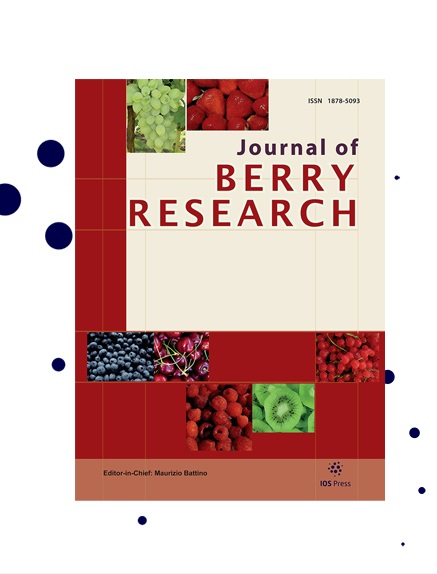Alleviating heat stress during early-season establishment of containerized strawberry transplants
IF 1.4
4区 农林科学
Q3 PLANT SCIENCES
引用次数: 0
Abstract
BACKGROUND:Earlier planting under subtropical climatic conditions has been proposed as a means of increasing strawberry (Fragaria×ananassa Duch.) profitability but exposes transplants to heat stress. OBJECTIVE:Therefore, physical and chemical methods of ameliorating heat stress on the establishment, growth, and yield of containerized strawberry transplants were evaluated. METHODS:We used a split-plot design with white-on-black (white) mulch and black mulch as main plot treatments; and a factorial arrangement of transplant type and stress-prevention application was randomly assigned to the subplots. ‘Florida Radiance’ Jiffy plug and tray plug transplants were treated either with s-abscisic acid or with kaolin. RESULTS:White mulch resulted in greater plant vigor and vegetative growth than black mulch. Kaolin plus white mulch provided protection against heat stress as indicated by increased photosynthesis rates. At 4 weeks after transplanting, plant vigor and shoot growth were higher and flowering occurred earlier with Jiffy plug transplants than with tray plug transplants. Early marketable yields were higher with white mulch than with black mulch in three of the four site years. CONCLUSIONS:A combination of white mulch, Jiffy plug transplants, and kaolin application appears to have the best potential for alleviating heat stress during early-season strawberry establishment under subtropical conditions.减轻草莓集装箱移栽季前栽培时的热胁迫
背景:在亚热带气候条件下的早期种植被认为是提高草莓(Fragaria×ananassa Duch.)收益的一种手段,但移栽会暴露在热胁迫下。目的:研究热胁迫对草莓容器移栽植株建立、生长和产量的影响。方法:采用分块设计,以白对黑(白色)地膜和黑色地膜为主要小区处理;按移栽类型和抗逆性施用随机分配。‘Florida Radiance’Jiffy塞和托盘塞移栽用s-脱落酸或高岭土处理。结果:白色地膜比黑色地膜更有利于植物活力和营养生长。高岭土加白色地膜可以提高光合作用速率,防止热胁迫。移栽后4周,即刻插拔比托盘插拔植株活力和芽部生长更高,开花时间更早。在4个立地年份中,有3年覆盖白色地膜的早期可售产量高于覆盖黑色地膜的。结论:在亚热带条件下,白色覆盖、快速插拔移栽和高岭土施用组合对缓解早季草莓种植过程中的热胁迫效果最好。
本文章由计算机程序翻译,如有差异,请以英文原文为准。
求助全文
约1分钟内获得全文
求助全文
来源期刊

Journal of Berry Research
Biochemistry, Genetics and Molecular Biology-Biochemistry
CiteScore
3.50
自引率
11.80%
发文量
21
期刊介绍:
The main objective of the Journal of Berry Research is to improve the knowledge about quality and production of berries to benefit health of the consumers and maintain profitable production using sustainable systems. The objective will be achieved by focusing on four main areas of research and development:
From genetics to variety evaluation
Nursery production systems and plant quality control
Plant physiology, biochemistry and molecular biology, as well as cultural management
Health for the consumer: components and factors affecting berries'' nutritional value
Specifically, the journal will cover berries (strawberry, raspberry, blackberry, blueberry, cranberry currants, etc.), as well as grapes and small soft fruit in general (e.g., kiwi fruit). It will publish research results covering all areas of plant breeding, including plant genetics, genomics, functional genomics, proteomics and metabolomics, plant physiology, plant pathology and plant development, as well as results dealing with the chemistry and biochemistry of bioactive compounds contained in such fruits and their possible role in human health. Contributions detailing possible pharmacological, medical or therapeutic use or dietary significance will be welcomed in addition to studies regarding biosafety issues of genetically modified plants.
 求助内容:
求助内容: 应助结果提醒方式:
应助结果提醒方式:


